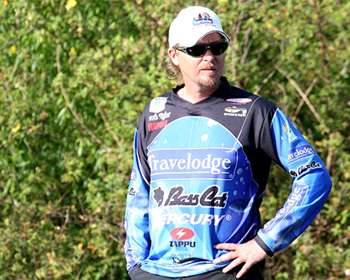
When the temperature climbs toward the triple digits and cloudless skies stretch as far as the eye can see, all but the hardcore bass anglers head for the comfort of air conditioning and relief from the cosmic rays.
For tournament anglers, however, calling it quits early isn't an option. Cutting his teeth on the West Coast, Elite Series pro Mark Tyler quickly learned that fishing shade was critical to success in many of the region's ultraclear waters. "My theory is that the clearer the water, the more important shade becomes," says Tyler, who now calls Oklahoma home.
"Especially when fishing reservoirs like Lake Mead, shade is of the utmost importance. The water is gin clear, so the bass will actually use the shade line as both cover and an ambush point. I learned at an early age that you can't fish on the West Coast without learning how to utilize shade." For Tyler, the shade pattern shines during the dog days of summer.
Early in the year, Tyler will actually avoid fishing shade, noting that when the water is cold, bass will actually seek out sunny banks in an attempt to warm themselves. When it comes to finding shade on the water, Tyler looks beyond the obvious and finds shade that many anglers might overlook. "Shade comes in a lot of forms, depending on the lake that you are fishing," he explains. "It could be matted vegetation, a physical structure, like a boat dock, or the angle of the bank. What a lot of people don't realize is that there are also shaded areas that aren't visible on the surface of the water."
These underwater shaded areas are created by breaklines or dropoffs that run at a particular angle to the sun and cast an underwater shadow that is not visible on the surface. In order to find these hidden gems, Tyler studies topographical maps and compares the layout of the lake to the angle of the sun at a particular time.
When the shade bite is on, Tyler will plan his morning based on the timing and location of shaded areas. "In a lot of instances, I've based my day around where the shade lines will be," he explains. "I've fished tournaments on Lake Mead where shade has been my primary pattern for the majority of the day. As the sun rises, I will choose my bank knowing that I will be fishing shaded areas for at least half of the day. You can actually follow the angle of the sun and chase the shade lines."
Once he has located shaded areas, Tyler then finds the prime ambush points where the bass will be positioned. "Bass are edge creatures, so I'll never overlook the edge of a shade line," says Tyler. "If I could only make one cast, it would be to an edge, be it a dock, weedline or shade line." While the edge line may be the "hot spot" in a patch of shade, Tyler explores all of the shaded area; he knows that bass could be positioned anywhere within the shaded region.
Although shade may play a more critical role on deep, clear, rocky reservoirs, Tyler has also found that shade can create shallow-water opportunities as well. On the California Delta, where he set the BASS big bass record with a 14-pound, 9-ounce brute in 1999, Tyler often uses shade to reposition the bass relating to shallow bushes. "I'll focus on a specific row of bushes because I know how the sun is going to cast a shadow on the area and position the fish," he explains. "If you really start to pay attention and think about the sun angle and shade pockets, you can really use it to your advantage," Tyler noted.




